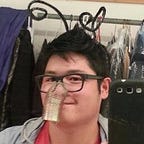Last time, I wrote about how Jubilee, while aesthetically dope, never truly becomes the Asian hero we need. Hisako Ichiki (aka Armor), I feel, redeems a point in Asian representation.
Hisako is a new-ish character to X-Men with her first appearance in 2004. Hailing from Japan, her mutant ability is to create an enormously powerful and impenetrable psionic exoskeleton around her body. She can make it gigantic and at one point, even fights a Godzilla-sized dragon named Fin Fang Foom. (Yeah, that character was definitely made in the 60s by a white guy. Thanks, Stan Lee.)
I haven’t read every issue Armor is in, but every time she gets into a fight she’s such a fucking bad-ass. She’s nearly always the last woman standing — simply because she’s so strong and down-right angsty.
The angst is my favorite part. Even though she’s a junior member of the X-Men, she’s always out to prove herself… and then pretty much does it. In 2018's X-Men: Extermination , she basically tells Jean Grey (one of the most iconic mutant queens) that she can fuck-off after an argument about how to deal with the end of the world. (Spoiler alert: Armor was kinda right.) Storylines pivot with Armor, something you love to see from an Asian woman.
When comparing the designs of Jubilee (my last post) and Armor, Armor is way more… Asian. And it kinda makes sense from a cultural standpoint: Jubilee is a Chinese American from Los Angeles and Armor is from Tokyo, Japan. The credited creator, Joss Whedon (yes, that white guy), doesn’t let you forget it. Her ability basically allows her to pilot a giant, psychic Gundam-styled mecha suit; She becomes another tag-along buddy to Wolverine (who notoriously has connections to the Far East); Her powers are also spiritually linked to her ancestors and she gets stronger anytime one of her family members die.
Wait a second. She gets stronger as her family dies? So, we have to kill more Japanese characters for this one to be better? I’ll admit, it sounds fucked up. (By the way, throughout the series, the writers kill off four of her family members.) And at face value, it’s easy to see this as a simplification of just another “honor” or “vengeance” plot that’s stereotypical for Asian characters.
But here… it feels right. A ton of Asian cultures (Japan included) have pillars around filial piety and the veneration of the dead. So, it’s fitting to have a Japanese character who can make a psychic suit of armor get a spiritual power boost when her ancestral battery gets bigger.
We can have arguments on whether Whedon intended this as a trope or as an homage to Armor’s Japanese heritage. But stereotypes aside, I think what he’s done shows the beauty of what happens when you have Asian characters tie back to their cultural source material — it makes that Asian-ness integral to the character. It makes the heritage something to be embraced instead of letting it become a footnote.
One of Hisako’s first major arcs is when her mother and brother get caught in a fatal car accident and she has to leave X-Men training in the USA to attend the funeral in Japan. The whole time, she’s devastated—harboring the guilt that she was not with her family to protect them. She also believed her father blamed her for abandoning them. (Asian parent guilt is very powerful. #iykyk)
During the funeral, Fin Fang Foom attacks Tokyo and Hisako decides leave the services to fight him along with her fellow X-Men. Her father becomes furious when she leaves, until he realizes his daughter managed to put aside her own grief to attend to something greater. When she returns (triumphant), he embraces her and tells her he has never been so proud. The father-daughter moment is a bit of a cliche, but I think it works to develop Armor as a character—Asian-ness and all.
When Asian representation embraces Asian-ness, it makes those cultures more accessible and more easily understood for all. Disney’s Mulan (the cartoon version, please) is another great example of why this type of cultural representation matters. Every spring for Tomb Sweeping Day (掃墳節), my family participates in hang san — a Chinese ritual where we visit the graves of our loved ones, burn incense, and offer them wine and ceremonial foods. Essentially, a graveyard picnic with grandma and grandpa’s spirits. Whenever I have to explain this to my non-Asian friends, without a doubt they’ll say: “Oh, like Mulan?” Yes. Pretty much like Mulan.
Good Asian representation makes connections. If you’re Asian, seeing Asian-ness in characters like Armor in a comic book or movie or advertising helps you feel more connected to that story. It deepens the affinity. And if you’re not Asian, then characters like Armor might help you understand and connect to the people who come from those cultures, no matter how distant they are to your own.
This post is part 2 of 6 in a larger thinky-think series using Marvel’s X-Men as a way to help cope, educate, and discuss #StopAsianHate. For more, follow me on Instagram (@ZakMoy)
